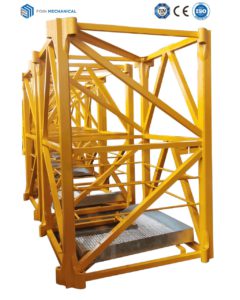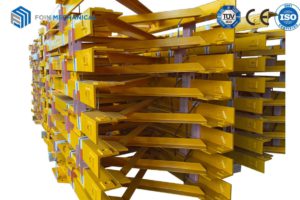How to choose a suitable tower crane? | Procurement Guide
Tower crane selection matters
Tower cranes are widely used in high-rise buildings, industrial plants, large complex buildings, bridges, hydropower stations and other construction sites. There are many models. We can comprehensively consider the types of tower cranes according to the characteristics of the construction project and other factors and determine the model used of tower crane. Of course, some natural factors besides the construction environment should be considered such as transportation conditions, climatic conditions, etc.
I: Clarify the basic parameters
The working radius, height, maximum capacity and mast section types of the tower crane determine the ultimate value of the tower crane. The larger the maximum lifting load, the higher the final using height and the longer the working radius decide the higher the price of the tower crane.
Working radius: The working radius for the horizon boom tower crane is the horizontal distance from the root of the tower crane boom to the far end of the boom. The working radius of the luffing jib tower crane is the projected length of the boom length.The working radius required of the tower crane boom is determined according to the diagonal length of the building plan.
Maximum height: The height required under the hook of the tower crane needs to be 6-10 meters more than the highest height of the building.

The maximum lifting capacity:The maximum lifting capacity required of the tower crane depends on the weight of the heaviest cargo lifted in a single lifting of the construction project and its location on the floor plan.
Mast section types: include fixed type and split type. Fixed type is cheaper but not convenient to transport. Split type is more expensive but easy to transport. In addition, the cross-sectional area of different mast sections is different for example 1.2X1.2, 1.6X1.6, 2.0X2.0 (more details).
We need to consider the issue of the installation location.
According to the tower crane boom length, height and maximum lifting capacity, we usually divide it into three price ranges:
| Price Range (USD) | Radius (m) | Max Load (t) | Free Height (m) |
|---|---|---|---|
| 41000~48500 | 48-60 | 4-6 | 32-40 |
| 51500~85500 | 60-65 | 8-10 | 40-60 |
| 85500~147000 | 65-75 | 10-16 | 44-60 |
| Rate:1USD=6.8CNY (03/11/2020) |
Before purchasing a tower crane, it is a more sensible choice to do a good job in the tower crane market research combining the construction workload and the using period. Only in this way can we choose a tower crane that is more cost-effective and highly functional.
II: Determination of tower crane installation method
There are four main ways to install tower cranes:
A, Stationary type.It requires prefabricated installation foundation. Tower crane is installed outside the building. Using mast sections needs to reach the maximum height from the ground, The stationary type of tower crane is suitable for most construction environments where the space is not narrow and installation or disassembly are simple and easy, and the cost is low.
B, Internal climbing type. It prefabricated installation foundation is required. Tower crane installs inside the elevator shaft of the building, the bottom of the tower crane is suspended from the ground after the independent height is exceeded, and the 8 outriggers are used for positioning and climbing on the elevator shaft wall, this type of tower crane is more suitable for construction that is impossible to install tower cranes outside the property or super high-rise buildings, and the process of raising and dismantling is complicated. After completion, the cost of removing the tower crane from the top floor to the ground is usually a large amount fees, but for super high-rise buildings and narrow spaces it is the best choice.
C, Chassis weight type.It does not need for prefabricated installation foundation, it is suitable for short-term construction, and the maximum height does not exceed 150 meters, which is convenient for quick installation and transfer. Other features are the same as the stationary type.
D,Traveling chassis type.It needs to lay the track, the maximum using height is the free standing height of the tower crane, it is a very good choice for you when the height requirement is not high, but tower crane needs to cover a longer construction area for example, the airport terminal , Industrial plants, etc.

Stationary external type

Stationary internal type

Chassis weight type tower crane
III: Confirmation of tower crane work type
Tower cranes are classified according to their work types: horizontal tower cranes (topless/flat-top and topkit/hammerhead tower crane) and luffing jib tower cranes.
Horizontal boom tower crane. it is suitable for most construction projects provided that the tower crane can rotate freely within 270-360 degrees. Since the horizontal boom of the tower crane is a fixed whole after assembly, it is necessary to consider whether the boom will interfere with nearby buildings or other tower cranes working or other potential safety hazards during operation (product model list).
Summary:Horizontal boom tower cranes are suitable for most projects with ample space and good construction conditions.
Tips: The flat-top/topless tower crane is a new trend in the development of tower cranes, which can meet the requirements of more flexible changing of boom length and the environment where multiple tower cranes are used in high density.(TTK4510; TK5013; TK5612; TK6015; TK6024; TK6520
TL4020; TL5610; TL6015; TL6520; TL6513; TL7022; TL7032; TL8522)
Luffing jib tower crane. It is suitable to be used in some crowded and narrow spaces. In most of the construction of the project in old urban areas, clients must choose the luffing jib tower crane to carry out the lifting operation due to the dense surrounding buildings and the complex environment and We need to avoid various obstacles in the process of completing the lifting operation . Working methods of the luffing jib tower crane is more flexible to meet various complex construction requirements(product model list).

Tips: Both the horizontal boom and the luffing boom tower crane can be manufactured in any of the installation methods eg. Stationary; internal climbing; chassis weight,;and traveling chassis installation methods.(LF3020; LF4015; LF5023)
To sum up: First of all, we need to clarify the tower crane’s maximum height, maximum lifting weight, maximum working radius, and then you can determine stationary, internal climbing, chassis weight, and traveling chassis installation methods and finally determine the using environment choosing horizontal boom tower crane or luffing jib tower crane to meet different using environments.
Summary: Luffing jib tower cranes are suitable for most projects with narrow space and complex construction conditions.





Comments (2)
Yes, different building types require different tower cranes, choosing a smart partner will make things simple and efficient, do you agree? cheers
We are glad that what we shared can help you.